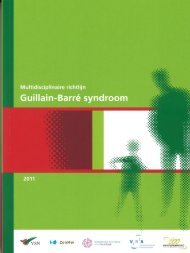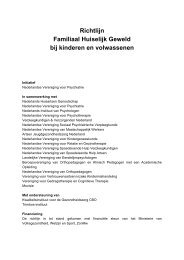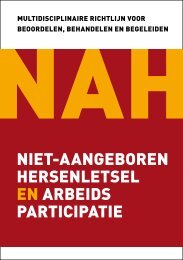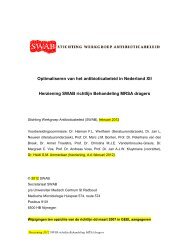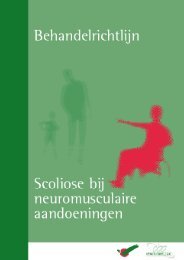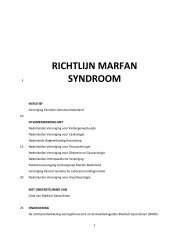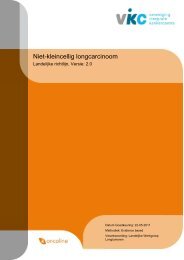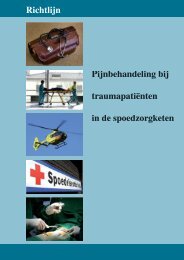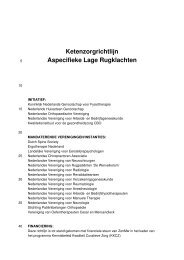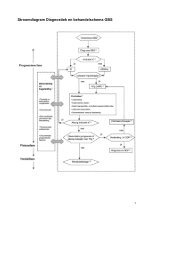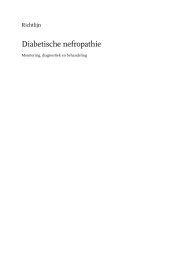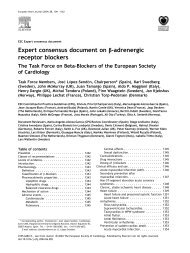Richtlijn: Otitis Externa - Kwaliteitskoepel
Richtlijn: Otitis Externa - Kwaliteitskoepel
Richtlijn: Otitis Externa - Kwaliteitskoepel
You also want an ePaper? Increase the reach of your titles
YUMPU automatically turns print PDFs into web optimized ePapers that Google loves.
• AAO-HNSF 2006: The guideline of the AAO-HNSF discusses persisting AOE, meaning AOE that<br />
does not dissolve despite topic treatment. If initial therapy does not respond within 48-72<br />
hours, the ear should be reassessed. The clinician should inspect the ear, perform otoscopy<br />
and or cleaning of the ear. A culture is advised.<br />
• NHG-Standaard 2005: In case an ear wick soaked in topical medication is used, the acute<br />
symptoms of AOE should dissolve within 24 hours. When the symptoms do not dissolve<br />
within a week using eardrops , the ear should be reassessed and cleaned. This should be<br />
repeated after another week of topical treatment. If however symptoms persist after three<br />
weeks despite therapy, a culture is advised together with active screening for contact allergy.<br />
After six weeks of continuing complaints of AOE a chronic middle ear disease should be<br />
considered. Patients should be referred to an otorhinolaryngologist in case of fever or if they<br />
have a compromised immune system or a combination of diabetes mellitus and general<br />
weakness. When symptoms persist for more than five to six weeks or frequent episodes of<br />
OE occur, referral to an otorhinolaryngologist is also advised.<br />
• Cochrane review 2010: The review discusses treatment of acute otitis externa, persistent or<br />
chronic otitis externa is not subject of the review. It is stated that symptoms of AOE last for<br />
approximately six days once treatment has commenced. When symptoms do not resolve<br />
within two weeks of treatment, the treatment is considered a failure and an alternative<br />
therapy should be considered. The options for alternative therapy are not described. The<br />
review mentions a specialist referral percentage of 3%. Surgical treatment for chronic<br />
(recurrent) OE is not described.<br />
Conclusies<br />
Level of evidence 3<br />
Observational<br />
studies<br />
Causes for persistent AOE are obstructed ear canal, poor patient adherence<br />
to therapy and misdiagnosis (see table 2). In these cases the differential<br />
diagnosis and possible modifying factors should be reassessed.<br />
Overwegingen<br />
Uit literatuur blijkt dat de meeste patiënten met AOE na twee weken hersteld zijn. In de derde week<br />
treedt er weinig additioneel herstel op, daarom is een termijn van 3 weken gerechtvaardigd voordat<br />
een AOE persisterend wordt genoemd (Van Balen 2003).<br />
Aanbeveling<br />
In het geval een acute otitis externa langer dan drie weken aanhoudt, ondanks therapie, dient de<br />
differentiaal diagnose (1a) en factoren van invloed op het ziektebeloop/behandeling (1b) opnieuw in<br />
overweging genomen te worden. Daarnaast dient een aantal misdiagnosen uitgesloten te worden<br />
(zie tabel), de strategie wordt weergegeven in het onderstaande stroomschema.<br />
35 <strong>Richtlijn</strong> <strong>Otitis</strong> <strong>Externa</strong> 2010<br />
Nederlandse Vereniging voor Keel-Neus-Oorheelkunde en Heelkunde van het Hoofd-Halsgebied




